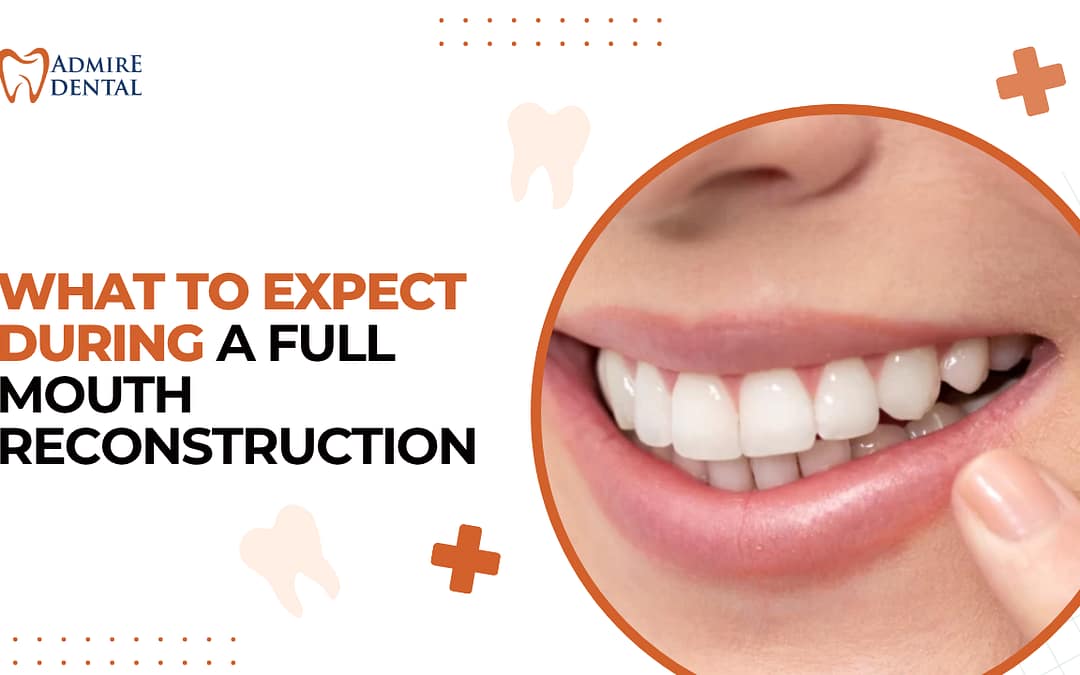If you’ve struggled with multiple dental problems such as tooth loss, worn down enamel, or persistent jaw pain, then a complete mouth reconstruction might be the answer to restoring both your smile as well as the function of your mouth. In contrast to cosmetic procedures which focus on only aesthetics the full mouth reconstruction process is a complete restorative process which improves the health, appearance, and structure of your mouth in all its aspects.
Let’s go over all there is to learn about the definition of what it is, what steps to take, as well as what you can expect to experience during and following the procedure.
What Is a Full Mouth Reconstruction?
The full-mouth reconstruction process, sometimes referred to as full restoration or rehabilitation of the mouth is the process of replacing or rebuilding every tooth in the mouth of a patient. It is a combination of various dental procedures, including bridges, crowns and veneers as well as orthodontics, based on the health condition of your gums and teeth.
This treatment is typically suggested for people who
- Are there multiple missing or damaged teeth that are severely damaged or missing
- Do you suffer from jaw pain that is chronic, jaw issues, or problems.
- Experiment tooth loss because of grinding or wear from acid
- Have you suffered trauma or injury which affected several teeth
The goal is to restore function, comfort and confidence in your smile.
Step 1: Consultation and Evaluation
The first step is to conduct a thorough dental examination. In this appointment the dentist will:
- Examine your gums, teeth and jaw alignment
- Make digital X-rays, 3D scans or impressions
- Talk about with your doctor about the history of your health, your lifestyle, and your goals
This is a crucial step since each full mouth reconstruction procedure is personalized. Your dentist will decide on the best combination of cosmetic and restorative procedures that will meet your specific requirements.
When you’ve completed this stage, you’ll receive a customized treatment plan, which will outline the steps, timeline, and the costs.
Step 2: Treatment Planning
When the exam is completed and your dentist has completed the assessment, they will lay out a step-by-step treatment program. This could comprise:
- Periodontal treatment (if gingivitis is evident)
- Treatments for root canals to treat teeth that are infected
- Dental implants or bridges can replace teeth that are missing
- Crowns or veneers that restore damaged or worn teeth
- Orthodontic procedure (like braces, aligners or even) to correct the misalignment
- Adjustment of the bite to ensure an uniform pressure distribution
The treatment plan may be carried out in stages, depending on the nature of your case. The focus isn’t just on appearance, but on ensuring that your jaw and teeth function in harmony.
Step 3: Restorative Procedures Begin
After your treatment plan has been approved Your dentist will start your reconstruction. It could involve any or all options:
- Dental Implants titanium posts are surgically inserted into the jawbone in order to repair tooth roots. These are and then crowns are added for an appearance that is natural and functional.
- Dental Crowns and Bridges: Used to reinforce damaged teeth or to replace missing teeth.
- Veneers are thin shells that are placed at the top of the teeth to improve the shape as well as alignment.
- Onlays and Inlays: Partially restored restorations that help preserve the original tooth’s structure.
- Orthodontics Orthodontics: Braces, or aligners that are clear can serve to fix alignment and bite issues prior to the placement of restorations.
Each stage could require several appointments, particularly when healing time is required between the procedures (for instance, following implants).
Step 4: Temporary Restorations and Adjustments
Before the permanent restorations are put in place the dentist will provide temporarial bridges or crowns. This can help:
- Check your bite and feel comfortable
- You can adjust to the new sensation of your teeth
- Make sure chewing and speaking are not a fad
The dentist will make minor adjustments according to your feedback in order to make sure the final results are lasting and comfortable.
Step 5: Final Placement and Smile Reveal
After your jaw and gums are healed and all adjustments have been made The dentist will apply your permanent dental restorations. Then you’ll be able finally to show your new smile which is natural looking is comfortable and performs flawlessly.
It will also be examined repeatedly, and your dentist will check that every tooth is aligned correctly and you can chew comfortably without discomfort.
Step 6: Recovery and Aftercare
The degree of recovery will depend on the nature of your procedure. If extractions or implants were carried out, a little soreness, swelling or a slight discomfort may be expected for some days. Your dentist could prescribe medications and recommend a diet that is soft for the initial period of healing.
To keep your beautiful smile:
- Make sure to floss and brush regularly
- Visit your dentist for follow-ups
- Avoid choking on hard objects or using teeth to make tools.
- Reduce your smoking and your alcohol consumption
It is important to schedule regular cleanings and checks to ensure that your restorations remain in good state.
How Long Does a Full Mouth Reconstruction Take?
The timeline can vary from a few months to one year, based on things like:
- Procedures required
- The healing time between surgeries
- Your general oral health
Your dentist will provide you with an concept of the anticipated duration according to the treatment program.
Benefits of Full Mouth Reconstruction
A complete reconstruction of the mouth can be a life-changing change that enhances functionality as well as confidence. Here are some of the important advantages:
- Improves the ability to chew and talk correctly
- Improves the appearance of smiles and self-esteem.
- Corrects jaw and bite problems. discomfort.
- It strengthens damaged or weak teeth.
- Enhances the health and longevity of your mouth. of natural teeth
It’s not about just aesthetics, it’s about restoring your life quality.
Final Thoughts
A complete reconstruction of the mouth is a major, yet rewarding experience. It is ideal for people who have endured years of dental issues and would like an unaffected beautiful, healthy and attractive smile. Modern dentistry and the most advanced techniques, your dentist is able to create a plan for reconstruction that will return your mouth’s function to its fullest and gives patients the ability to smile once more.
If you’re thinking about this procedure make an appointment with a reputable dentist. Together, you’ll develop a path to an improved, healthier you – each step at a.
Faqs
-
How long will a complete mouth reconstruction require?
The time frame varies according to the treatment plan. It could take between a few months and one year, particularly in cases where multiple healing or procedures are required.
-
Are full mouth reconstructions painful?
The majority of procedures are done under local anesthesia, or sedation meaning you won’t feel any discomfort during the procedure. The slight discomfort or soreness that follows is normal and is easily treated by a prescription for pain relief.
-
What dental issues could be fixed with a complete mouth reconstruction?
It is a solution to broken or worn teeth jaw pain, gum disease teeth alignment, bite misalignment, and aesthetic issues like uneven or discolored teeth.
-
What is the cost of a complete oral reconstruction set?
The cost will vary based on the degree of difficulty and the type of procedures that are required. It is possible to vary therefore your dentist should give you a precise estimate following the initial exam as well as the treatment program.
-
What are the time frames for outcomes of complete restoration of the mouth last?
By maintaining a good oral hygiene regimen and regular dental check-ups and the right care, results can last for a long time. The highest-quality restorations such as crowns and implants are made for long-term longevity.



